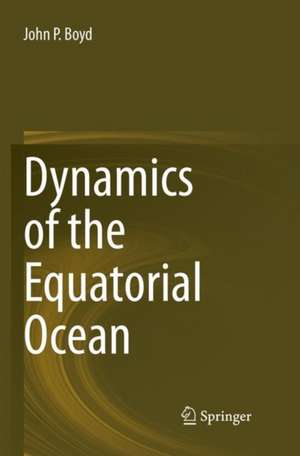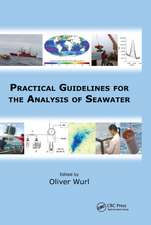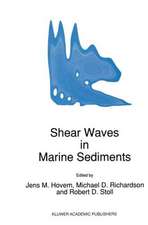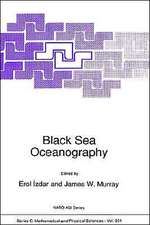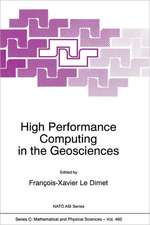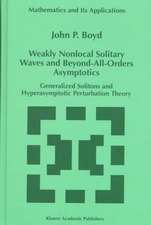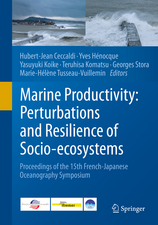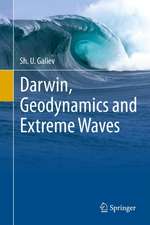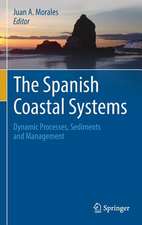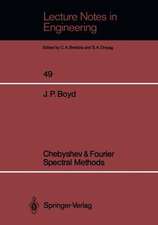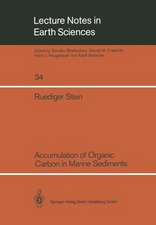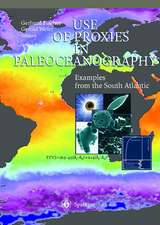Dynamics of the Equatorial Ocean
Autor John P. Boyden Limba Engleză Paperback – 15 aug 2018
| Toate formatele și edițiile | Preț | Express |
|---|---|---|
| Paperback (1) | 1161.37 lei 38-44 zile | |
| Springer Berlin, Heidelberg – 15 aug 2018 | 1161.37 lei 38-44 zile | |
| Hardback (1) | 1690.55 lei 6-8 săpt. | |
| Springer Berlin, Heidelberg – 6 oct 2017 | 1690.55 lei 6-8 săpt. |
Preț: 1161.37 lei
Preț vechi: 1528.13 lei
-24% Nou
Puncte Express: 1742
Preț estimativ în valută:
222.22€ • 232.65$ • 183.88£
222.22€ • 232.65$ • 183.88£
Carte tipărită la comandă
Livrare economică 01-07 aprilie
Preluare comenzi: 021 569.72.76
Specificații
ISBN-13: 9783662572351
ISBN-10: 3662572354
Pagini: 517
Ilustrații: XXIV, 517 p. 159 illus., 27 illus. in color.
Dimensiuni: 155 x 235 mm
Greutate: 0.83 kg
Ediția:Softcover reprint of the original 1st ed. 2018
Editura: Springer Berlin, Heidelberg
Colecția Springer
Locul publicării:Berlin, Heidelberg, Germany
ISBN-10: 3662572354
Pagini: 517
Ilustrații: XXIV, 517 p. 159 illus., 27 illus. in color.
Dimensiuni: 155 x 235 mm
Greutate: 0.83 kg
Ediția:Softcover reprint of the original 1st ed. 2018
Editura: Springer Berlin, Heidelberg
Colecția Springer
Locul publicării:Berlin, Heidelberg, Germany
Cuprins
1 An Observational Overview of the Equatorial Ocean
1.1 The Thermocline: the Tropical Ocean as a Two-Layer Model . . . . . . 1.2 Equatorial Currents
1.3 The Somali Current and the Monsoon 1.4 Deep Internal Jets
1.5 The El Nino/Southern Oscillation (ENSO) 1.6 Upwelling in the Gulf of Guinea
1.7 Seasonal Variations of the Thermocline
1.8 Summary
2 Basic Equations and Normal Modes
2.1 Model .
2.2 Boundary conditions 2.3 Separation of Variables
2.4 Lamb’s Parameter and all 2.5 Vertical Modes and Layer Models .
2.6 Nondimensionalization
3&nb
sp; Kelvin, Yanai, Rossby and Gravity Waves 3.1 Latitudinal wave modes: an overview
3.2 Latitudinal wave modes
3.3 Dispersion relation
3.4 Analytic Approximations to Equatorial Wave Frequencies
3.4.1 Explicit formulas
3.4.2 Long wave series
3.5 Separation of Time Scales 3.6 Forced Waves
3.7 How the Mixed-Rossby Gravity Wave Earned Its Name 3.8 Hough-Hermite Vector Basis
3.8.1 Introduction 3.8.2 Inner Product and Orthogonality
3.8.3 Orthonormal Basis Functions 3.9 Hough-Hermite Applications
3.10 Initialization Through Hough-Hermite Expansion
3.11 Energy Relationships
3.12&nbs
p; The Equatorial Beta-Plane as the Thin Limit of the Nonlinear Shallow Water Equations on the Sphere
4 The “Long Wave” Approximation & Geostrophy 4.1 Introduction
4.2 Quasi-Geostrophy 4.3 “Meridional Geostrophy” Approximation
4.4 Boundary Conditions 4.5 Frequency Separation of Slow [Rossby/Kelvin] and Fast [Gravity]
Waves 4.6 Long Wave Initial Value Problems
4.7 Reflection From an Eastern Boundary in the Long Wave
Approximation
4.7.1 The Method of Images
4.7.2 Dilated Images
4.7.3 Zonal Velocity
4.8 Forced Problems in the Long Wave Approximation
5 Coastally Trapped Waves and Ray-
Tracing5.1 Introduction 5.2 Coastally-Trapped Waves
5.3 Ray-Tracing for Coastal Waves
5.4 Ray-Tracing on the Equatorial Beta-plane
5.5 Coastal & Equatorial Kelvin Waves
5.6 Topographic and Rotational Rossby Waves and Potential Vorticity
6 Reflections and Boundaries 6.1 Introduction
6.2 Reflection of Midlatitude Rossby Waves from a Zonal Boundary 6.3 Reflection of Equatorial Waves from a Western Boundary
6.4 Reflection from an Eastern Boundary 6.5 The Meridional Geostrophy/Long Wave Approximation and Boundaries
6.6 Quasi-Normal Modes: Definition and Other Weakly Non-existent Phenomena 6.7 Quasi-Normal Modes in the Long Wa
ve Approximation: Derivation6.8 Quasi-Normal Modes in the Long Wave Approximation: Discussion 6.9 High Frequency Quasi-Free Equatorial Oscillations
6.10 Scattering & Reflection from Islands
7 Response of the Equatorial Ocean to Periodic Forcing
7.1 Introduction 7.2 A Hierarchy of Models for Time-Periodic Forcing
7.3 Description of the Model and the Problem 7.4 Numerical models: Reflections and “Ringing”
7.5 Atlantic versus Pacific 7.6 Summary
8 Impulsive Forcing and Spin-up
8.1 Introduction
8.2 The Reflection of the Switched-On Kelvin Wave
8.3 Spin-up of a Zonally-Bounded Ocean: Overv
iew8.4 The Interior (Yoshida) Solution 8.5 Inertial-Gravity Waves
8.6 Western Boundary Response 8.7 Sverdrup Flow on the Equatorial Beta-Plane
8.8 Spin-Up: General Considerations 8.9 Equatorial Spin-up: Details
8.10 Equatorial Spin-up: Summary
9 Yoshida Jet and Theories of the Undercurrent
9.1 Introduction
9.2 Wind-Driven Circulation in an Unbounded Ocean: f-plane 9.3 The Yoshida Jet
9.4 An Interlude: Solving Inhomogeneous Differential Equations at Low Latitudes 9.4.1 Forced eigenoperators: Hermite series
9.4.2 Hutton-Euler Acceleration of Slowly Converging Hermite Series 9.4.3 Regularized Forci
ng 9.4.4 Bessel Function Explicit Solution for the Yoshida Jet 9.4.5 Rational Approximations: Two-Point Pade Approximants
and Rational Chebyshev Galerkin Methods 9.5 Unstratified Models of the Undercurrent
9.5.1 Theory of Fofonoff and Montgomery (1955) 9.5.2 Model of Stommel (1960)
9.5.3 Gill(1971) and Hidaka (1961)
10 Stratified Models of Mean Currents
10.1 Introduction
10.2 Modal Decompositions for Linear, Stratified Flow
10.3 Different Balances of Forces 10.3.1 Bjerknes Balance
10.4 Forced Baroclinic Flow 10.4.1 Other Balances
10.5 The Sensitivity of the Undercurrent to Parameters 10.6 Observations of the Tsuchiya Jets
10.7 Alternate Methods for Vertical Structure with Viscosit
y 10.8 McPhaden’s Model of the EUC and SSCC’s: Results
10.9 A Critique of Linear Models of the Continuously-Stratified Ocean
11 Waves and Beams in the Continuously Stratified Ocean 11.1 Introduction
11.1.1 Equatorial beams: A Theoretical Inevitability 11.1.2 Slinky Physics and Impedance Mismatch, or How Water
Cn Be As Reflective As Silvered Glass 11.1.3 Shallow Barriers to Downward Beams
11.1.4 Equatorial methodology 11.2 Alternate Form of the Vertical Structure Equation
11.3 The Thermocline as a Mirror
11.4 The Mirror-Thermocline Concept: A Critique
11.5 The Zonal Wavenumber Condition for Strong Excitation of a Mode
11.6 Kelvin Beams: Background
11.7 Equatorial Kelvin Beams: Results
12 Stable Waves in Shear
12.1 Introduction 12.2 U (y): Pure Latitudinal Shear
12.3 Waves in Two-Dimensional Shear 12.4 Vertical Shear and the Method of Multiple Scales
13 Inertial Instability and Deep Equatorial Jets
13.1 Introduction: Stratospheric Pancakes & Equatorial Deep Jets 13.2.1 Linear Inertial Instability
13.3 Centrifugal Instability: Rayleigh’s Parcel Argument
13.4 Equatorial Gamma-Plane Approximation
13.5 Dynamical Equator
13.6 Gamma-plane Instability
13.7 Mixed Kelvin-Inertial Instability
13.8 Summary
14 Kelvin Wave Instability 14.1 Proxies and the Optical Theorem
14.2 Six Ways to Calculate Kelvin Instability
14.2.1 Power Series for the Eigenvalue
14.2.2 Hermite-Padé Approximants
14.2.3 Numerical
14.3 Instability for t
he Equatorial Kelvin Wave In the Small Wavenumber Limit 14.3.1 Beyond-All-Orders Rossby Wave Instability
14.3.2 Beyond-All-Orders Kelvin Wave Instability in Weak Shear in the Long Wave Approximation
14.4 Kelvin Instability in Shear: the General Case
15 Nonmodal Instability 15.1 Introduction
15.2 Couette and Poiseuille Flow & Subcritical Bifurcation 15.3 The Fundamental Orr
15.4 Interpretation: the “Venetian Blind Effect”
15.5 Refinements to the Orr Solution
15.6 The “Checkerboard” and Bessel Solution
15.6.1 The “Checkerboard” Solution
15.7 The Dandelion Strategy
15.8 Three-Dimensional Transients
15.9 ODE Models & Nonnormal Matrices
15.10Nonmodal Instability in the Tropics 15.11Summary
16 No
nlinear Equatorial Waves 16.1 Introduction
16.2 Weakly Nonlinear Multiple Scale Perturbation Theory
16.2.1 Reduction From Three Space Dimensions to One
16.2.2 Three Dimensions & Baroclinic Modes
16.3 Solitary and Cnoidal Waves
16.4 Dispersion and Waves
16.4.1 Derivation of the Group Velocity Through the Method of Multiple Scales
16.5 Integrability, Chaos and the Inverse Scattering method 16.6 Low Order Spectral Truncation (LOST)
16.7 Nonlinear Equatorial Kelvin Waves 16.7.1 Physics of the One-Dimensional Advection (ODA) equation
16.7.2 Post-Breaking: Overturning, Taylor shock or “soliton clusters” . . . . . . . . . . . . . . . . . . . . . . 16.7.3 Viscous regularization of Kelvin fronts: Burgers’ equation
ad matched asymptotic pertubation tery 16.8 Kelvin-Gravity Wave Shortwave Resonance: Curving Fronts
andUndulations 16.9 Kelvin solitary and cnoidal waves
16.10Corner Waves and the Cnoidal-Corner-Breaking Scenario
16.11Rossby Solitary Waves
16.12Antisymmetrc Latitudinal Modes & MKdV Eq
16.13Shear effects on nonlinear equatorial waves
16.14Equatorial Modons
16.15A KdV alternative: the Regularized Long Wave (RLW) equation
16.15.1The useful non-uniqueness of perturbation theory 16.15.2Eastward-traveling modons and other cryptozoa
16.16Phenomenology of the Korteweg-deVries Equation on an unbounded domain
16.16.1Standard form/group invariance
16.16.2The KdV equation and longitudinal boundaries
16.16.3Calculating the Solitons Only
16.16.4Elastic soliton collisions
16.16.5Periodic BC
16.16.6The KdV cnoidal wave 16.17Soliton Myths and Amazements
16.17.1Imbricate series & the Nonlinear Superposition Principle 16.17.2The Lemniscate Cnoidal Wave: Strong Overlap of the
Soliton and Sine Wave Regimes 16.17.3Solitary waves are not special
16.17.4Why “Solitary Wave” is the most misleading term in
oceanography
16.17.5Scotomas and discovery: the Lonely Crowd
16.18Weakly nonlocal solitary waves .
16.18.1Background
16.18.2Initial Value Experiments 16.18.3Nonlinear Eigenvalue Solutions
16.19Tropical Instability Vortices 16.20The Missing Soliton Problem
17 Nonlinear Wavepackets and Nonlinear Schroedinger Equation
17.1 The Nonlinear Schroedinger Equation for Weakly Nonlinear
Wavepackets: Envelope Solitons, FPU Recurrence and Sideband
Instability
17.2 Linear Wavepackets
17.2.1 Perturbation Parameters
17.3 Derivation of the NLS Equation from the KdV Equation 17.3.1 NLS Dilation Group Invariance
17.3.2 Defocusing 17.3.3 Focusing, envelope solitons and resonance
17.3.4 Nonlinear plane wave 17.3.5 Envelope solitary wave
17.3.6 NLS cnoidal & dnoidal
17.3.7 N-soliton solutions
17.3.8 Breathers
17.3.9 Modulational (“sideband”) instability, self-focusing and FPU Recurrence
17.4 KdV from NLS 17.4.1 The Landau constant: Poles and resonances
17.5 Weakly Dispersive Waves 17.6 Numerical Experiments
17.7 Nonlinear Schroedinger equation (NLS) summary
17.8 Resonances: Triad, Second Harmonic & Long-Wave Short Wave
17.9 Second Harmonic Resonance
17.9.1 Barotropic/baroclinic triads 17.10Long Wave/Short Wave Resonance
17.10.1Landau constant poles
17.11Triad Resonances: The General Case Continued) 17.11.1A Brief Catalog of Triad Concepts
17.11.2Rescalings
17.11.3The general explicit solutions
17.12Linearized Stability Theory
17.12.1Vacillation and Index Cycles 17.12.2Euler Equations and Football
17.12.3Lemniscate Case
17.12.4Instability & the Lemniscate Case 17.13Resonance Conditions: A Problem in Algebraic Geometry
17.13.1Selection Rules and Qualitative Properties 17.13.2Limitations of Triad Theory
17.14Solitary Waves in Numerical Models
17.15Gerstner Trochoidal Waves and Lagrangian Coordinate Descriptions of Nonlinear Waves 17.16Potential Vorticity Inversion
17.16.1A Proof That the Linearized Kelvin Wave Has Zero Potential Vorticity
17.17Coupled systems of KdV or RLW equations
A Hermite Functions A.1 Normalized Hermite Functions: Definitions and Recursion
A.2 Raising and Lowering Operators
A.3 Integrals of Hermite Polyno
mials and Functions A.4 Integrals of Products of Hermite Functions
A.5 Higher Order and Symmetry-Preserving Recurrences A.6 Unnormalized Hermite Polynomials
A.7 Zeros of Hermite Series
A.8 Zeros of Hermite Functions A.9 Gaussian Quadrature
A.9.1 Gaussian Weighted A.9.2 Unweighted Integrand
A.10 Pointwise Bound on Normalized Hermite Functions
A.11 Asymptotic Approximations A.11.1 Interior Approximations
A.11.2 Airy Approximation Near the Turning Points
A.12 Convergence Theory
A.13 Abel-Euler Summability, Moore’s Trick, and Tapering
A.14 Alternative Implementation of Euler Acceleration A.15 Tapering
A.16 Hermite Functions on a Finite Interval
A.17 Hermite-Galerkin Numerical Models A.18 Fourier Transform
A.19 Integral Representations
B&nb
sp; Expansion of the Wind-Driven Flow in Vertical ModesC Potential Vorticity and Y C.1 Potential Vorticity
C.2 Potential Vorticity Inversion
C.3 Mass-Weighted Streamfunction C.3.1 General Time-Varying Flows
C.3.2 Streamfunction for Steadily-Traveling Waves
C.4 Streakfunction
C.5 The Streamfunction for Small Amplitude Traveling Waves
C.6 Other Nonlinear Conservation Laws
Glossary
Index
References
1.1 The Thermocline: the Tropical Ocean as a Two-Layer Model . . . . . . 1.2 Equatorial Currents
1.3 The Somali Current and the Monsoon 1.4 Deep Internal Jets
1.5 The El Nino/Southern Oscillation (ENSO) 1.6 Upwelling in the Gulf of Guinea
1.7 Seasonal Variations of the Thermocline
1.8 Summary
2 Basic Equations and Normal Modes
2.1 Model .
2.2 Boundary conditions 2.3 Separation of Variables
2.4 Lamb’s Parameter and all 2.5 Vertical Modes and Layer Models .
2.6 Nondimensionalization
3&nb
sp; Kelvin, Yanai, Rossby and Gravity Waves 3.1 Latitudinal wave modes: an overview
3.2 Latitudinal wave modes
3.3 Dispersion relation
3.4 Analytic Approximations to Equatorial Wave Frequencies
3.4.1 Explicit formulas
3.4.2 Long wave series
3.5 Separation of Time Scales 3.6 Forced Waves
3.7 How the Mixed-Rossby Gravity Wave Earned Its Name 3.8 Hough-Hermite Vector Basis
3.8.1 Introduction 3.8.2 Inner Product and Orthogonality
3.8.3 Orthonormal Basis Functions 3.9 Hough-Hermite Applications
3.10 Initialization Through Hough-Hermite Expansion
3.11 Energy Relationships
3.12&nbs
p; The Equatorial Beta-Plane as the Thin Limit of the Nonlinear Shallow Water Equations on the Sphere
4 The “Long Wave” Approximation & Geostrophy 4.1 Introduction
4.2 Quasi-Geostrophy 4.3 “Meridional Geostrophy” Approximation
4.4 Boundary Conditions 4.5 Frequency Separation of Slow [Rossby/Kelvin] and Fast [Gravity]
Waves 4.6 Long Wave Initial Value Problems
4.7 Reflection From an Eastern Boundary in the Long Wave
Approximation
4.7.1 The Method of Images
4.7.2 Dilated Images
4.7.3 Zonal Velocity
4.8 Forced Problems in the Long Wave Approximation
5 Coastally Trapped Waves and Ray-
Tracing5.1 Introduction 5.2 Coastally-Trapped Waves
5.3 Ray-Tracing for Coastal Waves
5.4 Ray-Tracing on the Equatorial Beta-plane
5.5 Coastal & Equatorial Kelvin Waves
5.6 Topographic and Rotational Rossby Waves and Potential Vorticity
6 Reflections and Boundaries 6.1 Introduction
6.2 Reflection of Midlatitude Rossby Waves from a Zonal Boundary 6.3 Reflection of Equatorial Waves from a Western Boundary
6.4 Reflection from an Eastern Boundary 6.5 The Meridional Geostrophy/Long Wave Approximation and Boundaries
6.6 Quasi-Normal Modes: Definition and Other Weakly Non-existent Phenomena 6.7 Quasi-Normal Modes in the Long Wa
ve Approximation: Derivation6.8 Quasi-Normal Modes in the Long Wave Approximation: Discussion 6.9 High Frequency Quasi-Free Equatorial Oscillations
6.10 Scattering & Reflection from Islands
7 Response of the Equatorial Ocean to Periodic Forcing
7.1 Introduction 7.2 A Hierarchy of Models for Time-Periodic Forcing
7.3 Description of the Model and the Problem 7.4 Numerical models: Reflections and “Ringing”
7.5 Atlantic versus Pacific 7.6 Summary
8 Impulsive Forcing and Spin-up
8.1 Introduction
8.2 The Reflection of the Switched-On Kelvin Wave
8.3 Spin-up of a Zonally-Bounded Ocean: Overv
iew8.4 The Interior (Yoshida) Solution 8.5 Inertial-Gravity Waves
8.6 Western Boundary Response 8.7 Sverdrup Flow on the Equatorial Beta-Plane
8.8 Spin-Up: General Considerations 8.9 Equatorial Spin-up: Details
8.10 Equatorial Spin-up: Summary
9 Yoshida Jet and Theories of the Undercurrent
9.1 Introduction
9.2 Wind-Driven Circulation in an Unbounded Ocean: f-plane 9.3 The Yoshida Jet
9.4 An Interlude: Solving Inhomogeneous Differential Equations at Low Latitudes 9.4.1 Forced eigenoperators: Hermite series
9.4.2 Hutton-Euler Acceleration of Slowly Converging Hermite Series 9.4.3 Regularized Forci
ng 9.4.4 Bessel Function Explicit Solution for the Yoshida Jet 9.4.5 Rational Approximations: Two-Point Pade Approximants
and Rational Chebyshev Galerkin Methods 9.5 Unstratified Models of the Undercurrent
9.5.1 Theory of Fofonoff and Montgomery (1955) 9.5.2 Model of Stommel (1960)
9.5.3 Gill(1971) and Hidaka (1961)
10 Stratified Models of Mean Currents
10.1 Introduction
10.2 Modal Decompositions for Linear, Stratified Flow
10.3 Different Balances of Forces 10.3.1 Bjerknes Balance
10.4 Forced Baroclinic Flow 10.4.1 Other Balances
10.5 The Sensitivity of the Undercurrent to Parameters 10.6 Observations of the Tsuchiya Jets
10.7 Alternate Methods for Vertical Structure with Viscosit
y 10.8 McPhaden’s Model of the EUC and SSCC’s: Results
10.9 A Critique of Linear Models of the Continuously-Stratified Ocean
11 Waves and Beams in the Continuously Stratified Ocean 11.1 Introduction
11.1.1 Equatorial beams: A Theoretical Inevitability 11.1.2 Slinky Physics and Impedance Mismatch, or How Water
Cn Be As Reflective As Silvered Glass 11.1.3 Shallow Barriers to Downward Beams
11.1.4 Equatorial methodology 11.2 Alternate Form of the Vertical Structure Equation
11.3 The Thermocline as a Mirror
11.4 The Mirror-Thermocline Concept: A Critique
11.5 The Zonal Wavenumber Condition for Strong Excitation of a Mode
11.6 Kelvin Beams: Background
11.7 Equatorial Kelvin Beams: Results
12 Stable Waves in Shear
12.1 Introduction 12.2 U (y): Pure Latitudinal Shear
12.3 Waves in Two-Dimensional Shear 12.4 Vertical Shear and the Method of Multiple Scales
13 Inertial Instability and Deep Equatorial Jets
13.1 Introduction: Stratospheric Pancakes & Equatorial Deep Jets 13.2.1 Linear Inertial Instability
13.3 Centrifugal Instability: Rayleigh’s Parcel Argument
13.4 Equatorial Gamma-Plane Approximation
13.5 Dynamical Equator
13.6 Gamma-plane Instability
13.7 Mixed Kelvin-Inertial Instability
13.8 Summary
14 Kelvin Wave Instability 14.1 Proxies and the Optical Theorem
14.2 Six Ways to Calculate Kelvin Instability
14.2.1 Power Series for the Eigenvalue
14.2.2 Hermite-Padé Approximants
14.2.3 Numerical
14.3 Instability for t
he Equatorial Kelvin Wave In the Small Wavenumber Limit 14.3.1 Beyond-All-Orders Rossby Wave Instability
14.3.2 Beyond-All-Orders Kelvin Wave Instability in Weak Shear in the Long Wave Approximation
14.4 Kelvin Instability in Shear: the General Case
15 Nonmodal Instability 15.1 Introduction
15.2 Couette and Poiseuille Flow & Subcritical Bifurcation 15.3 The Fundamental Orr
15.4 Interpretation: the “Venetian Blind Effect”
15.5 Refinements to the Orr Solution
15.6 The “Checkerboard” and Bessel Solution
15.6.1 The “Checkerboard” Solution
15.7 The Dandelion Strategy
15.8 Three-Dimensional Transients
15.9 ODE Models & Nonnormal Matrices
15.10Nonmodal Instability in the Tropics 15.11Summary
16 No
nlinear Equatorial Waves 16.1 Introduction
16.2 Weakly Nonlinear Multiple Scale Perturbation Theory
16.2.1 Reduction From Three Space Dimensions to One
16.2.2 Three Dimensions & Baroclinic Modes
16.3 Solitary and Cnoidal Waves
16.4 Dispersion and Waves
16.4.1 Derivation of the Group Velocity Through the Method of Multiple Scales
16.5 Integrability, Chaos and the Inverse Scattering method 16.6 Low Order Spectral Truncation (LOST)
16.7 Nonlinear Equatorial Kelvin Waves 16.7.1 Physics of the One-Dimensional Advection (ODA) equation
16.7.2 Post-Breaking: Overturning, Taylor shock or “soliton clusters” . . . . . . . . . . . . . . . . . . . . . . 16.7.3 Viscous regularization of Kelvin fronts: Burgers’ equation
ad matched asymptotic pertubation tery 16.8 Kelvin-Gravity Wave Shortwave Resonance: Curving Fronts
andUndulations 16.9 Kelvin solitary and cnoidal waves
16.10Corner Waves and the Cnoidal-Corner-Breaking Scenario
16.11Rossby Solitary Waves
16.12Antisymmetrc Latitudinal Modes & MKdV Eq
16.13Shear effects on nonlinear equatorial waves
16.14Equatorial Modons
16.15A KdV alternative: the Regularized Long Wave (RLW) equation
16.15.1The useful non-uniqueness of perturbation theory 16.15.2Eastward-traveling modons and other cryptozoa
16.16Phenomenology of the Korteweg-deVries Equation on an unbounded domain
16.16.1Standard form/group invariance
16.16.2The KdV equation and longitudinal boundaries
16.16.3Calculating the Solitons Only
16.16.4Elastic soliton collisions
16.16.5Periodic BC
16.16.6The KdV cnoidal wave 16.17Soliton Myths and Amazements
16.17.1Imbricate series & the Nonlinear Superposition Principle 16.17.2The Lemniscate Cnoidal Wave: Strong Overlap of the
Soliton and Sine Wave Regimes 16.17.3Solitary waves are not special
16.17.4Why “Solitary Wave” is the most misleading term in
oceanography
16.17.5Scotomas and discovery: the Lonely Crowd
16.18Weakly nonlocal solitary waves .
16.18.1Background
16.18.2Initial Value Experiments 16.18.3Nonlinear Eigenvalue Solutions
16.19Tropical Instability Vortices 16.20The Missing Soliton Problem
17 Nonlinear Wavepackets and Nonlinear Schroedinger Equation
17.1 The Nonlinear Schroedinger Equation for Weakly Nonlinear
Wavepackets: Envelope Solitons, FPU Recurrence and Sideband
Instability
17.2 Linear Wavepackets
17.2.1 Perturbation Parameters
17.3 Derivation of the NLS Equation from the KdV Equation 17.3.1 NLS Dilation Group Invariance
17.3.2 Defocusing 17.3.3 Focusing, envelope solitons and resonance
17.3.4 Nonlinear plane wave 17.3.5 Envelope solitary wave
17.3.6 NLS cnoidal & dnoidal
17.3.7 N-soliton solutions
17.3.8 Breathers
17.3.9 Modulational (“sideband”) instability, self-focusing and FPU Recurrence
17.4 KdV from NLS 17.4.1 The Landau constant: Poles and resonances
17.5 Weakly Dispersive Waves 17.6 Numerical Experiments
17.7 Nonlinear Schroedinger equation (NLS) summary
17.8 Resonances: Triad, Second Harmonic & Long-Wave Short Wave
17.9 Second Harmonic Resonance
17.9.1 Barotropic/baroclinic triads 17.10Long Wave/Short Wave Resonance
17.10.1Landau constant poles
17.11Triad Resonances: The General Case Continued) 17.11.1A Brief Catalog of Triad Concepts
17.11.2Rescalings
17.11.3The general explicit solutions
17.12Linearized Stability Theory
17.12.1Vacillation and Index Cycles 17.12.2Euler Equations and Football
17.12.3Lemniscate Case
17.12.4Instability & the Lemniscate Case 17.13Resonance Conditions: A Problem in Algebraic Geometry
17.13.1Selection Rules and Qualitative Properties 17.13.2Limitations of Triad Theory
17.14Solitary Waves in Numerical Models
17.15Gerstner Trochoidal Waves and Lagrangian Coordinate Descriptions of Nonlinear Waves 17.16Potential Vorticity Inversion
17.16.1A Proof That the Linearized Kelvin Wave Has Zero Potential Vorticity
17.17Coupled systems of KdV or RLW equations
A Hermite Functions A.1 Normalized Hermite Functions: Definitions and Recursion
A.2 Raising and Lowering Operators
A.3 Integrals of Hermite Polyno
mials and Functions A.4 Integrals of Products of Hermite Functions
A.5 Higher Order and Symmetry-Preserving Recurrences A.6 Unnormalized Hermite Polynomials
A.7 Zeros of Hermite Series
A.8 Zeros of Hermite Functions A.9 Gaussian Quadrature
A.9.1 Gaussian Weighted A.9.2 Unweighted Integrand
A.10 Pointwise Bound on Normalized Hermite Functions
A.11 Asymptotic Approximations A.11.1 Interior Approximations
A.11.2 Airy Approximation Near the Turning Points
A.12 Convergence Theory
A.13 Abel-Euler Summability, Moore’s Trick, and Tapering
A.14 Alternative Implementation of Euler Acceleration A.15 Tapering
A.16 Hermite Functions on a Finite Interval
A.17 Hermite-Galerkin Numerical Models A.18 Fourier Transform
A.19 Integral Representations
B&nb
sp; Expansion of the Wind-Driven Flow in Vertical ModesC Potential Vorticity and Y C.1 Potential Vorticity
C.2 Potential Vorticity Inversion
C.3 Mass-Weighted Streamfunction C.3.1 General Time-Varying Flows
C.3.2 Streamfunction for Steadily-Traveling Waves
C.4 Streakfunction
C.5 The Streamfunction for Small Amplitude Traveling Waves
C.6 Other Nonlinear Conservation Laws
Glossary
Index
References
Textul de pe ultima copertă
This book is the first comprehensive introduction to the theory of equatorially-confined waves and currents in the ocean. Among the topics treated are inertial and shear instabilities, wave generation by coastal reflection, semiannual and annual cycles in the tropic sea, transient equatorial waves, vertically-propagating beams, equatorial Ekman layers, the Yoshida jet model, generation of coastal Kelvin waves from equatorial waves by reflection, Rossby solitary waves, and Kelvin frontogenesis. A series of appendices on midlatitude theories for waves, jets and wave reflections add further material to assist the reader in understanding the differences between the same phenomenon in the equatorial zone versus higher latitudes.
Caracteristici
Contains appendices for illustrating special cases
Treats the important semiannual and annual cycles in the tropic sea
Includes complementary information to assist the reader in understanding the differences between the phenomenon in different latitudes
Includes supplementary material: sn.pub/extras
Treats the important semiannual and annual cycles in the tropic sea
Includes complementary information to assist the reader in understanding the differences between the phenomenon in different latitudes
Includes supplementary material: sn.pub/extras
